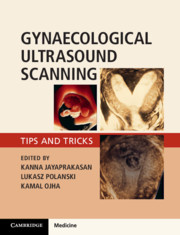Book contents
- Gynaecological Ultrasound Scanning
- Gynaecological Ultrasound Scanning
- Copyright page
- Contents
- Contributors
- Chapter 1 Get to Know Your Machine and Scanning Environment
- Chapter 2 Baseline Sonographic Assessment of the Female Pelvis
- Chapter 3 Difficult Gynaecological Ultrasound Examination
- Chapter 4 Sonographic Assessment of Uterine Fibroids and Adenomyosis
- Chapter 5 Sonographic Assessment of Congenital Uterine Anomalies
- Chapter 6 Sonographic Assessment of Endometrial Pathology
- Chapter 7 Sonographic Assessment of Polycystic Ovaries
- Chapter 8 Sonographic Assessment of Ovarian Cysts and Masses
- Chapter 9 Sonographic Assessment of Pelvic Endometriosis
- Chapter 10 Sonographic Assessment of Fallopian Tubes and Tubal Pathologies
- Chapter 11 Role of Ultrasound in Assisted Reproductive Treatment
- Chapter 12 Operative Ultrasound in Gynaecology
- Chapter 13 Sonographic Assessment of Complications Related to Assisted Reproductive Techniques
- Chapter 14 Sonographic Assessment of Early Pregnancy
- Chapter 15 Tips and Tricks when Using Ultrasound in a Contraception Clinic
- Chapter 16 Doppler Ultrasound in Gynaecology
- Index
- References
Chapter 2 - Baseline Sonographic Assessment of the Female Pelvis
Published online by Cambridge University Press: 28 February 2020
- Gynaecological Ultrasound Scanning
- Gynaecological Ultrasound Scanning
- Copyright page
- Contents
- Contributors
- Chapter 1 Get to Know Your Machine and Scanning Environment
- Chapter 2 Baseline Sonographic Assessment of the Female Pelvis
- Chapter 3 Difficult Gynaecological Ultrasound Examination
- Chapter 4 Sonographic Assessment of Uterine Fibroids and Adenomyosis
- Chapter 5 Sonographic Assessment of Congenital Uterine Anomalies
- Chapter 6 Sonographic Assessment of Endometrial Pathology
- Chapter 7 Sonographic Assessment of Polycystic Ovaries
- Chapter 8 Sonographic Assessment of Ovarian Cysts and Masses
- Chapter 9 Sonographic Assessment of Pelvic Endometriosis
- Chapter 10 Sonographic Assessment of Fallopian Tubes and Tubal Pathologies
- Chapter 11 Role of Ultrasound in Assisted Reproductive Treatment
- Chapter 12 Operative Ultrasound in Gynaecology
- Chapter 13 Sonographic Assessment of Complications Related to Assisted Reproductive Techniques
- Chapter 14 Sonographic Assessment of Early Pregnancy
- Chapter 15 Tips and Tricks when Using Ultrasound in a Contraception Clinic
- Chapter 16 Doppler Ultrasound in Gynaecology
- Index
- References
Summary
Ultrasound remains one of the most routinely performed medical investigations and a mainstay of clinical decision-making rests upon the obtained results. Due to the relative proximity of the pelvic organs to the abdominal surface and easy access via the vaginal route, gynaecological scanning should be in the armamentarium of every gynaecologist. As with every gynaecological assessment, and procedures of an intimate nature, explanation to alleviate anxiety and obtain informed consent is essential. The woman should feel safe and comfortable when the procedure is performed, which relates to the equipment in the scan room, presence of a chaperone and the security of the scan room. In this chapter, we will discuss the principles of sonographic assessment of the normal female pelvis.
- Type
- Chapter
- Information
- Gynaecological Ultrasound ScanningTips and Tricks, pp. 16 - 29Publisher: Cambridge University PressPrint publication year: 2020



